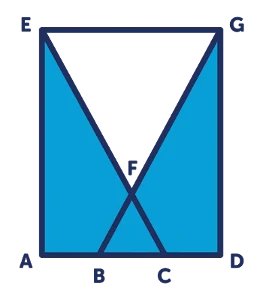Solving the toughest 2023 PSLE Maths question on Ratios and Fractions
- Tags:
- Primary Maths

Mathematics can be a challenging subject, and one of the most formidable aspects for many students is understanding and working with ratios and fractions. In the 2023 PSLE exam, students encountered a particularly tough maths question that put their knowledge to the test. In this article, we'll explore the intricacies of ratios and fractions and provide you with a step-by-step guide to conquer this challenging question.
Understanding Ratios And Fractions
Ratios are a way to compare two or more quantities, expressing their proportional relationship. Fractions, on the other hand, represent a part of a whole. In many maths problems, including the 2023 PSLE question we will discuss below, these concepts intertwine, and a solid grasp of them is essential.
Tackling the complex 2023 PSLE Maths Question on Ratios and Fractions
Question:
In the figure, \(\text{ADGE}\) is a rectangle where \(\mathrm{AB = BC = CD}\). \(\text{CE}\) intersects \(\text{BG}\) at \(\text{F}\). Given that the area ratio of \(\mathrm{\triangle AEC}\) to \(\mathrm{\triangle FBC}\) is \(8:1\), what fraction of rectangle \(\text{ADGE}\) is shaded?

Solution:
Let's look at the question,
We're told that \(\mathrm{\triangle AEC : \triangle FBC = 8 : 1}\)
So, if the area of \(\mathrm{\triangle FBC = 1}\) unit,
Then the area of \(\text{AEFB}\) would be \(8 - 1 = 7\) units.
Since \(\text{ADGE}\) is a rectangle, \(\text{AE}\) would be the same height as \(\text{GD}\).
This means that,
Area of \(\text{AEFB}\) = Area of \(\text{GFCD = 7}\) units.
So, if we add the area of \(\text{AEFB}\), area of \(\text{GFCD}\), and area of \(\mathrm{\triangle FBC}\), we get the area of the shaded area.
Therefore, the area of shaded area = \(7+7+1=15\) units.
Now, if we just knew the area of rectangle \(\text{ADGE}\), we'd be able to find the exact area of the shaded area.
How do we find that?
We know that \(\mathrm{AB = BC = CD}\) and that the area of \(\mathrm{\triangle AEC : \triangle FBC = 8 : 1}\).
Let's imagine that there was a straight line that went up straight from point \(\text{B}\). And let the point at which that line would have touched line \(\text{EG}\) be \(\text{K}\).
So, the rectangle \(\mathrm{KBDG}\) would be \(\displaystyle{\frac{2}{3}}\)rd of the rectangle \(\mathrm{AEGD}\), and \(\mathrm{\triangle KGB}\) would be 8 units.
This means that the area of \(\displaystyle{\frac{2}{3}}\)rd of the rectangle is \(8+1+7 = 16\) units.
And \(\displaystyle{1 \over 3}\)rd of the rectangle would be \(\displaystyle{\frac{16}{2}= 8}\) units.
This also means that the area of \(\displaystyle{3 \over 3}\) of the rectangle will be \(\displaystyle{8 \times 3 = 24}\) units.
We already know that the area of the shaded figure is 15 units.
The fraction of the shaded figure \(\displaystyle{={15 \over 24} = {5\over 8}}\).
Answer:
\(\displaystyle{\frac{5}{8}}\)
If your child enjoys solving math and science puzzles, you should explore Geniebook Arena. It's a free platform where groups of students work together to solve entertaining and challenging questions, with the chance to win exciting prizes. Don't forget to check it out!


 SG
SG  VN
VN 




















